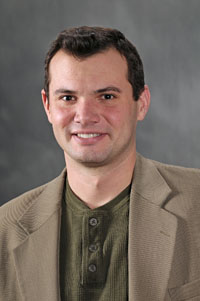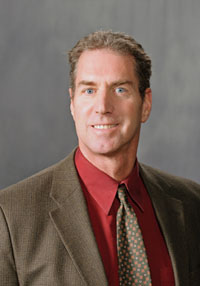|
By Mary McFarland

Phil Barnes, Policy Analysis, Research and Innovation assistant director; Alternative Finance Flagship Initiative leader. Photo by David Gonzalez |
As traffic and travel increase and the demands for transportation improvements rise, the short- and long-term concept for transportation funding is experiencing a shift toward alternative financing methods for construction projects.
MnDOT and other transportation organizations are currently coping with limited transportation funding resources, according to Phil Barnes, Alternative Finance Flagship Initiative leader. This “new normal” is forcing the department to look beyond traditional methods to finance transportation infrastructure.
MnDOT defines alternative transportation finance as any strategy that uses a new or non-traditional transportation funding source or uses existing funding source or techniques in a new way to deliver projects quickly and cost-effectively.
“One of the new revenue-generating strategies is to better align user benefits and costs,” Barnes said. “This means that those who will most benefit from the new transportation system would bear some of the costs.”
One example of this strategy is the Bren Road/Hwy 169 project in the western Twin Cities Metro Area. The project involved a partnership between the city of Minnetonka and UnitedHealth Group, which was interested in expanding its headquarters. The lack of interchange capacity at Bren Road and Hwy 169 also was becoming an issue for other businesses that wanted to expand in the area.
“To address the need for capacity at the interchange, staff recommended an ordinance to manage the development and pay for the improvements based on trips generated by the development,” said Lee Gustafson, Minnetonka city engineer.
The ordinance had three main points:
- No existing residential property will be affected by the ordinance unless the property is redeveloped into non-residential use.
- Only property owners (commercial/industrial/office) who wish to expand their building size will be affected by the ordinance.
- The approach is intended to have new development “pay its own way” where the payment is based on a project’s fair share of trips using the Bren Road and Hwy 169 interchange.
“Based on the ordinance, one of the larger users of the interchange, UnitedHealth Group, paid their fair share of interchange improvements, approximately $3.7 million, in order to proceed with the second phase of their development,” Gustafson said.

Matt Shands, alternative transportation finance staffer and coordinator. Photo by David Gonzalez |
Public/private partnership plays role in Hwy 10 interchange project
The Office of Alternative Finance also is looking at new types of partnerships between state, local and private entities.
“The cities and counties in MnDOT districts play an essential role in alternative financing as transportation partners for projects with regional benefits,” said Phil Barnes, Office of Alternative Finance director.
Barnes cited the Hwy 10/Otter Tail County Road 34 interchange project in District 4 as one example of a successful public/private partnership.
The city of Perham, with a population of under 3,000, needed to build a community hospital. The chosen site was near Hwy 10; however, there was no direct access to the highway, so the city of Perham requested an at-grade crossing be constructed near the proposed hospital site. Since the section of Hwy 10 that bypasses Perham was designed to interstate standards, an at-grade crossing in this section was considered unsafe, according to Les Bjerketvedt, District 4 project engineer.
Another option was County Road 34, which bridged Hwy 10 and from which ramps could be constructed to provide access between County Road 34 and Hwy 10 to the hospital site. The estimated $3 million project cost forced the city of Perham to look for alternative funding sources, according to Bjerketvedt. Additional funding proved unworkable until the creation of the 2010 Transportation Economic Development Pilot Program—a collaboration between MnDOT, the Department of Employment and Economic Development and the Public Facilities Authority. Funding from the Transportation Economic Development program was used to leverage both public and private resources, including $270,000 from local businesses that directly benefit from the new interchange.
Matt Shands, MnDOT’s alternative transportation finance staffer and coordinator of the 2010 TED pilot program, said the Perham interchange project is the type of project that the Alternative Finance Office hopes to be able to promote in the future with another round of TED funding or other funding sources.
“One of the keys to completing projects that otherwise would take years to program, is to leverage funding from our private and public partners who derive a direct benefit from these types of transportation improvements,” Shands said. “The TED program is an effective tool for doing that.”
The city of Perham, with the cooperation of local businesses, Otter Tail County and MnDOT, also applied to another DEED funding program for elements of the project located off the state right of way on the local road system. The two projects together extend from the west ramps on County Road 34 to the intersection of County Road 80.
“The projects, which require coordination between the state, county, city and consultants will be let as one project in April 2012,” Bjerketvedt said. The Perham hospital will be fully operational in January 2012.
Barnes said he plans to visit MnDOT’s district offices soon to learn more about successful alternative finance projects, and also explore which upcoming projects would benefit from alternative financing options.
“It is critical that we establish a framework to identify potential alternative financing projects and have measurement criteria in place to evaluate the results of these new approaches,” Barnes said.
For more information on alternative finance, visit www.dot.state.mn.us/funding/innovative/. |



